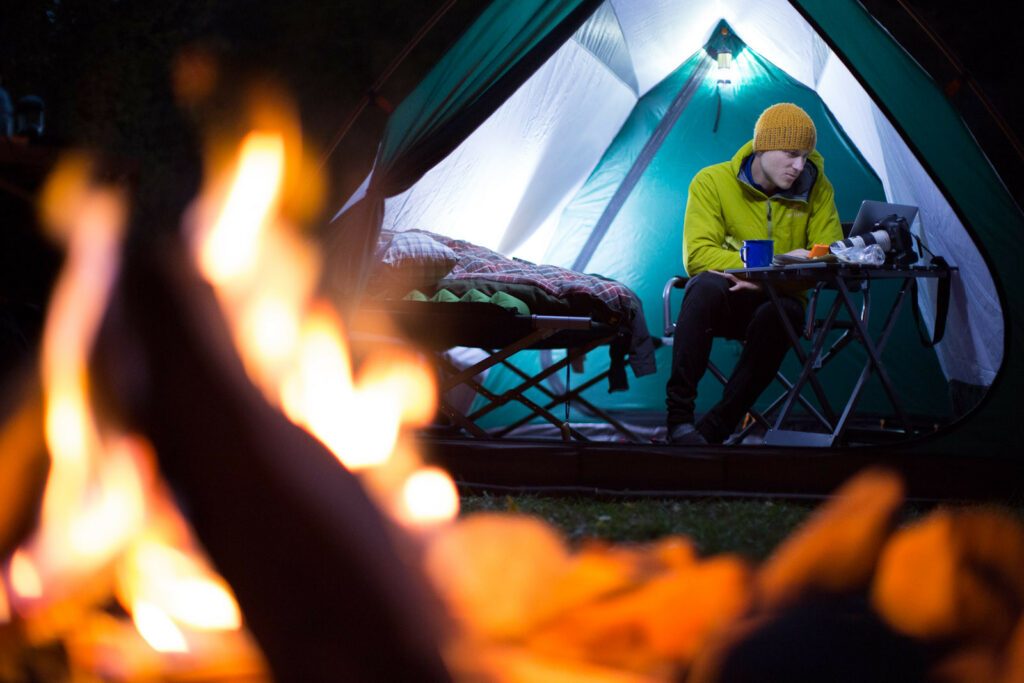The days are getting longer and the temperatures (theoretically) getting warmer from here on in, but for anyone experiencing cabin fever, there’s still more than a few weeks left to go before winter’s over.
Why not channel some of that stir-crazy spring energy into doing some winter camping?
March and April are the perfect time to get out on the land, especially if you’re not overly experienced or just not into the harsh temperatures and darkness that define most of the Northern winter, says Genevieve Côté of Fort Smith.
Côté, who teaches wilderness safety with her partner John Blyth, goes camping every winter, sometimes weekly, as a way to get out of town and spend time snowmobiling, ice fishing or skiing beyond the typical day trip.
According to Côté, there are three types of winter camping: cold camping, warm camping (with a stove) and staying in a cabin. While the latter is basically a more rustic form of daily living, camping with a tent in the winter takes additional equipment and preparation.
EDGE asked Côté and Blyth about their tips and tricks for spending enjoyable nights in the snowy wilderness.
Cold vs. Warm Camping
The longest Côté and Blyth have camped in winter without a stove was five days while skiing on the glaciers of Svalbard, where the lack of firewood made having a stove fairly impossible.
But even where wood is plentiful, quinzhees, lean-tos and even just regular four-season tents can make warm, enjoyable shelters for winter camping.
“The important thing is to find a good way to insulate yourself from the ground,” Côté says. If you’ve got a tent, close-celled foam is ideal for sleeping on, as inflatable mattresses don’t provide enough heat and can easily deflate.
If you’re in a more homemade shelter, Côté says a thick layer of spruce boughs is a must. They can even be placed in the bottom of a tent folded into a tarp for added insulation beneath your foam.
When it comes to warm tenting, there are a few options to consider. Côté and Blyth rock an Arctic Oven winter tent, which comes with a stove, but the most famous and popular Northern choice is the Fort McPherson canvas wall tent. Either option will allow you to stay warm and dry your gear, as long as you wake up in shifts to keep throwing wood on the fire.
Once you’ve experienced the challenge of cold camping, the pleasures of warm camping are all the more enjoyable, says Côté, who recommends everyone try both at least once — even if it’s just in the backyard.
Crucial gear
Apart from foam to sleep on, an obvious piece of essential gear is a sleeping bag rated for -30C. Down is a warm option, but is more expensive than synthetic. Synthetic on the other hand doesn’t pack as light as down, but stays warmer when damp.
No matter what kind of tent you’re staying in, Côté says you must dig down to the ground before setting it up, especially if your tent includes a stove. The snow will otherwise melt below, creating moisture and an uneven sleeping surface.
When it comes to clothing, Côté recommends layers. Boots and mitts should be equipped with removable liners that can be dried. If skidooing, one should have a lighter jacket for working around the camp. If skiing, bring a warmer set of gear to put on once you reach the camp to ensure you stay warm and dry.
“Moisture control is the number-one thing when winter camping,” Côté says. Bodies are always releasing steam in the cold, and sweating is a great way to become cold later. Quick-drying materials like wool and specially designed synthetics are key for staying warm.
For tools, Côté says she never leaves without a collapsible shovel, axe, folding saw, rope and a tarp, which can be used for everything from emergency shelter to carrying spruce boughs. On her body, she always has her headlamp tucked inside her jacket (for easy access and to keep the battery warm), along with a knife, and lighters in every pocket.
She also always packs a pot for melting snow into water, and a thermos for keeping water hot.
Hacks
Côté has a ton of tips and tricks for keeping cozy when winter camping. One of her mainstays is a pair of indoor booties (puffy slippers) for inside the tent when her boots are drying.
If you don’t have a stove to dry your gear, your best source of heat is your own body. Things you need to be warm and dry for the next day – like your boot liners — should be kept in your sleeping bag with you, otherwise they will be frozen solid in the morning. You will be surprised how much moisture your body heat can take out of damp garments.
When Côté packs her sleeping bag, she throws in a wool blanket, wool sleeping socks, a thin merino wool long-sleeved shirt and long-johns, a buff for her neck and, most importantly, a thin toque. She will then change her clothes right in the sleeping bag before going to sleep at night.
Because food freezes, it’s also important to consider what you pack to eat. Instant meals where you just have to add hot water are easiest, but if you’re going to have a fire outside, meat and fish with a high fat content is good for keeping energy reserves high.
Côté has a system down in terms of packing food. She freezes omelette mix, spaghetti sauce, soup, stew and even curry flat in ziploc bags, making them not only easy to thaw and reheat, but simple to transport on a bumpy skidoo ride. She also brings pre-mixed batter for frying fish and making bannock.
Because trails can be rough and cause a lot of jostling, Blyth says any canned beverages need to be transported separately in socks, otherwise they will burst just from rubbing together.
Must-dos
Like all adventures out on the land, Blyth says the basics include going with someone else whenever possible, letting people know where you’re going, and talking to people beforehand who know the area and can alert you to hazards like thin ice and overflow.
It’s also key to test your equipment before leaving to make sure it’s in working order. If it’s your first time winter camping, go somewhere close to town or even practice for a night in your backyard, which can also serve as a fun activity for your kids or friends to join.
Keep hydrated, Blyth says. People lose a lot of water in winter but often forget to drink fluids. Côté recommends a constant flow of warm tea, which not only keeps you warm and hydrated, but ensures you wake up in the night to put wood on the fire.
But, above all, take your time and do things properly.
“There’s no rush on the land; you are not in a race,” Côté says. Apart from getting sweaty by being in a hurry, rushing can cause you to wreck your toboggan or snowmobile, and cause injury or dehydration. Burns and frostbite are the most common kinds of injuries on the land, and are often caused by not taking the time to do things properly.
While having a few drinks with friends around a fire can be a nice time, Côté also warns against consuming alcohol while winter camping.
“It’s a big concern. You lose your faculties,” she says. “Cold is your worst enemy, so if you’re passing out in your tent, not feeding the stove or not covered properly, there’s so many things that can go wrong.”
Lastly, if you run into people out in the bush, she says, stop and visit.
“People are very social. They want to talk about trail conditions and any wildlife they’ve seen, so it’s just good bush etiquette,” she says. “And you will learn a lot. People who are out on the land a lot are happy to share information regarding the area.”







